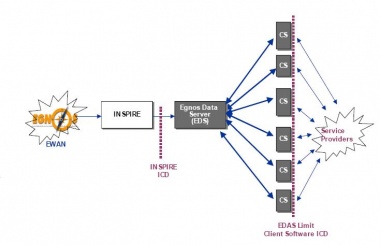If you wish to contribute or participate in the discussions about articles you are invited to contact the Editor
EGNOS Data Access Service (EDAS)
| EGNOS | |
|---|---|
| Title | EGNOS Data Access Service (EDAS) |
| Author(s) | GMV. |
| Level | Basic |
| Year of Publication | 2011 |
EDAS is the technical core of the EGNOS Commercial Data Distribution Service (CDDS) and provides the opportunity to deliver EGNOS data to users who cannot always view the EGNOS satellites (such as in urban canyons) or to support a variety of other value added services, applications and research programs.[1]
In 2006, the European Commission through the GJU (now superseded by the European GNSS Agency, the GSA) commissioned the EDAS system. EDAS allows any authorised entity to plug into EGNOS to receive the internal data collected, generated and delivered by EGNOS for free. Although the idea of providing GNSS data streams in real time is far from being new, EDAS has some key differentiators, the most important one is probably the service reliability planned for the post-beta test phase. Other benefits that EDAS brings are the high data rate (1Hz), the dissemination of the EGNOS message broadcast by each GEO satellite and the provision of GLONASS raw measurements. Additionally EDAS provides the raw data of the 34 Ranging and Integrity Monitoring Stations (RIMS) and Navigation Land Earth Stations (NLES).[1]
EDAS offers ground-based access to EGNOS data, it is the single point of access for the data collected and generated by the EGNOS infrastructure and it represents the terrestrial commercial data service provided by EGNOS.[2]
EDAS Overview
The main purpose of EDAS is to provide a basis for new applications beyond those from the nominal EGNOS Open Service and Safety of Life Service. To do so, the objective is to provide an interface point where multiple EGNOS Multimodal Service Providers can obtain the EGNOS products in real-time and within guaranteed delay, security, safety and performance boundaries. Actually there exists the possibility of binding and long-term service agreements. As a result EGNOS information broadcast through the GEO Signal In Space (SIS) becomes accessible, as well as the EGNOS Ranging, Integrity and Monitoring Stations (RIMS) raw data. EDAS delivers two main types of data in real-time, via ground transmission systems:
- EGNOS augmentation messages, also transmitted by EGNOS geostationary satellites.
- Raw GPS and GLONASS data collected by the EGNOS monitoring reference network.
EDAS Services
EDAS is not an end-user product. The data streams can be used by Service Providers to generate added value to the final customers by improving the availability and accuracy of the positioning. For instance, one may think of a Service Provider that takes the EGNOS message from EDAS and disseminates it to its customers through the Internet or GPRS.
EDAS provides two different service levels, which basically differ in the data formats they provide, namely an EDAS propietary format encoded in ASN.1(Service Level 0)[3] and RTCM (named Service Level 1).[4]
Data capture sample files of both service levels are available in GSA´s EDAS Web site (http://www.gsa.europa.eu/go/egnos/edas/documentation-download).
EDAS Architecture
The EDAS architecture is composed of the following elements:
- EDAS Client Software (CS): represents the functional interface between the EGNOS Data Server (EDS) and the Service Provider (SP) and it provides authentication, data communication and quota and integrity management.[5]
- EGNOS Data Server: transforms data received from INSPIRE (a dedicated interface to access to EGNOS data) from the EGNOS proprietary format to ASN.1 (SL0) and RTCM (SL1). For each message received EDS creates one or more RTCM messages and one ASN.1 message. In addition it delivers information to the CS about the status of the messages quota contracted by the SP.
EDAS also contains a Man Machine Interface (MMI) for daily operations, monitoring and control. All the elements (but the operator MMI) have redundancy in order to have high availability in the system. On top of that, security is an issue due to the fact that EDAS is connected to the heart of the EGNOS system and, in order to face it, EDAS has been protected and audited against intentional and unintentional attacks.[1]
EDAS Connections
Access to the EDAS data is possible by one of the two following means:[6]
- Internet connection allowing full transmission of all data on best-effort basis (no latency and data integrity guarantee).
- Higher performance point-to-point (PTP) direct link to the EDAS Server.
The standard and easiest way to receive EDAS is over the internet. Simply by downloading the client software, EDAS can be received through a typical broadband internet connection, where:
- ASN.1 format service requires 600kb/s.
- RTCM format service requires 300kb/s.
- Both formats can be received at 900kb/s.
It is possible to obtain a dedicated faster connection. This might require a fixed line solution providing a dedicated line for each user. The costs for introducing the fixed line solution to EDAS need to be covered by the user, but assistance and support in setting up the connection is provided.
EDAS Based Applications
Given the potential of the architecture deployed by EDAS, the diversity of data provided and its suitability for a wide range of environments and domains, it offers multiple opportunities for harnessing EDAS to provide applications and services,[7] specially for Redistribution of EGNOS augmentation messages and professional GNSS Services.
EDAS has proved to play a role within the identified market segments considered in the EGNOS CDDS. There is a continuously growing EDAS user community and there are a wide range of applications that provide EDAS-based services that comprise the CDDS.
Future Plans
In order to better meet user needs and attract new users and segments, EDAS is intended to be enhanced in terms of Service level and these enhancements will be fully backward compatible and the main ones considered are:[1]
Future plans for widening the provision of services that use EDAS, suggest:
- EDAS Based SISNET: EDAS could be used to provide enhanced availability of the SISNET[8] service and additional support through the EDAS helpdesk.
- Provision of FTP historical data: provision of archived EGNOS RIMS raw data and EGNOS messages through an FTP server could be interesting for potential services and professionals interested in post-processing this data.
- Server side data filtering, in order to reduce the bandwidth required by allowing the users to receive raw data from a limited of RIMS.
Notes
References
- ^ a b c d The EGNOS Service to Provide Ground Based Access to EGNOS – EDAS Beta test findings; Reinhard Blasi, GSA; Rafael Cardoso-Herce, Didier De Greef, ESSP; José Ramón López-Pérez, Francisco J. Jiménez-Roncero, AENA; Ángel Gavín-Alarcón, GMV; Monica Pesce, VVA; Proceedings of the 23rd International Technical Meeting of The Satellite Division of the Institute of Navigation (ION GNSS 2010), Portland, OR, September 2010
- ^ GSA's Introduction to EDAS
- ^ ASN.1 Format
- ^ RTCM 10403.1 Standard
- ^ EDAS Client Software User Manual-(GARMIS-GMV-6160-O-6162-U-V2.D.EDAS_CS_U).v3.A
- ^ EDAS Connection
- ^ EDAS Applications
- ^ SISNET Service


